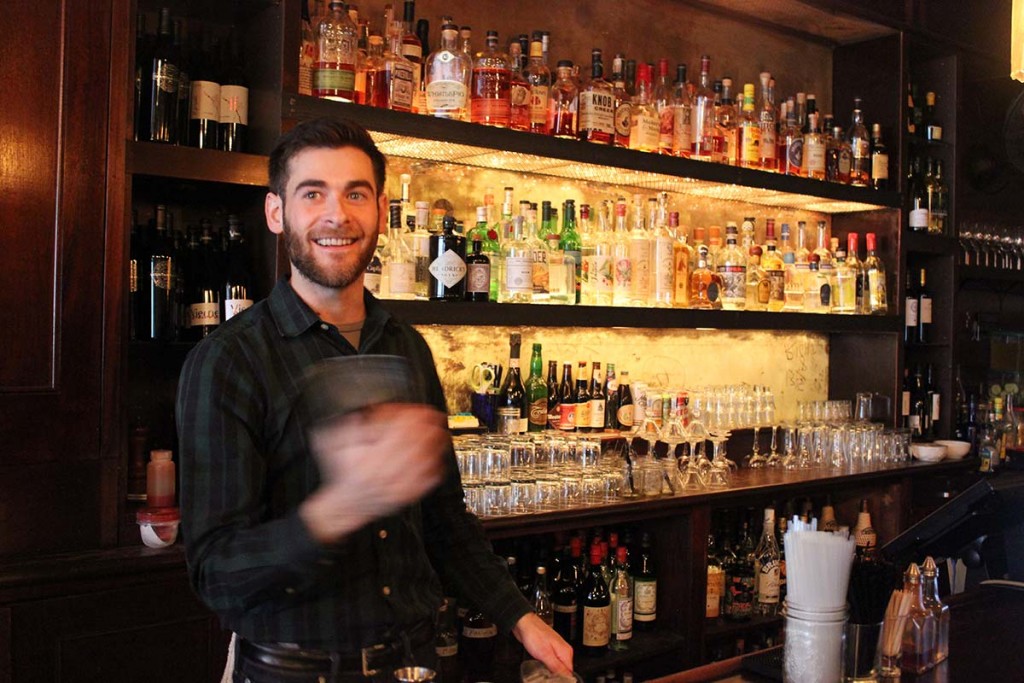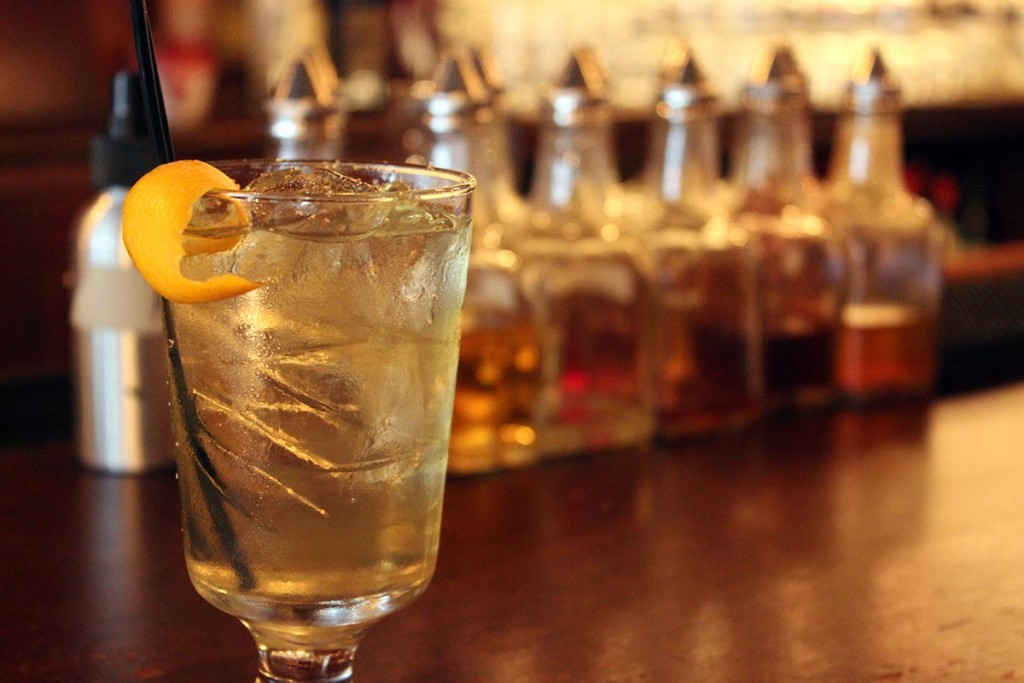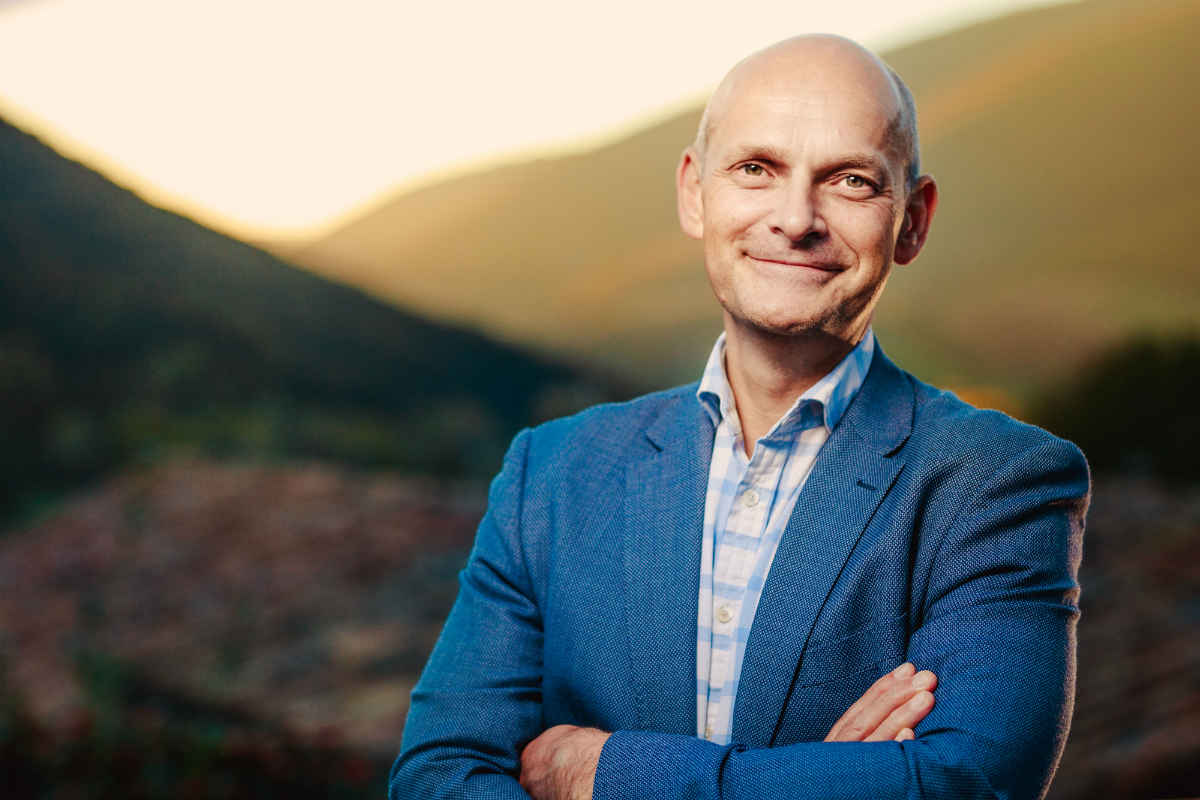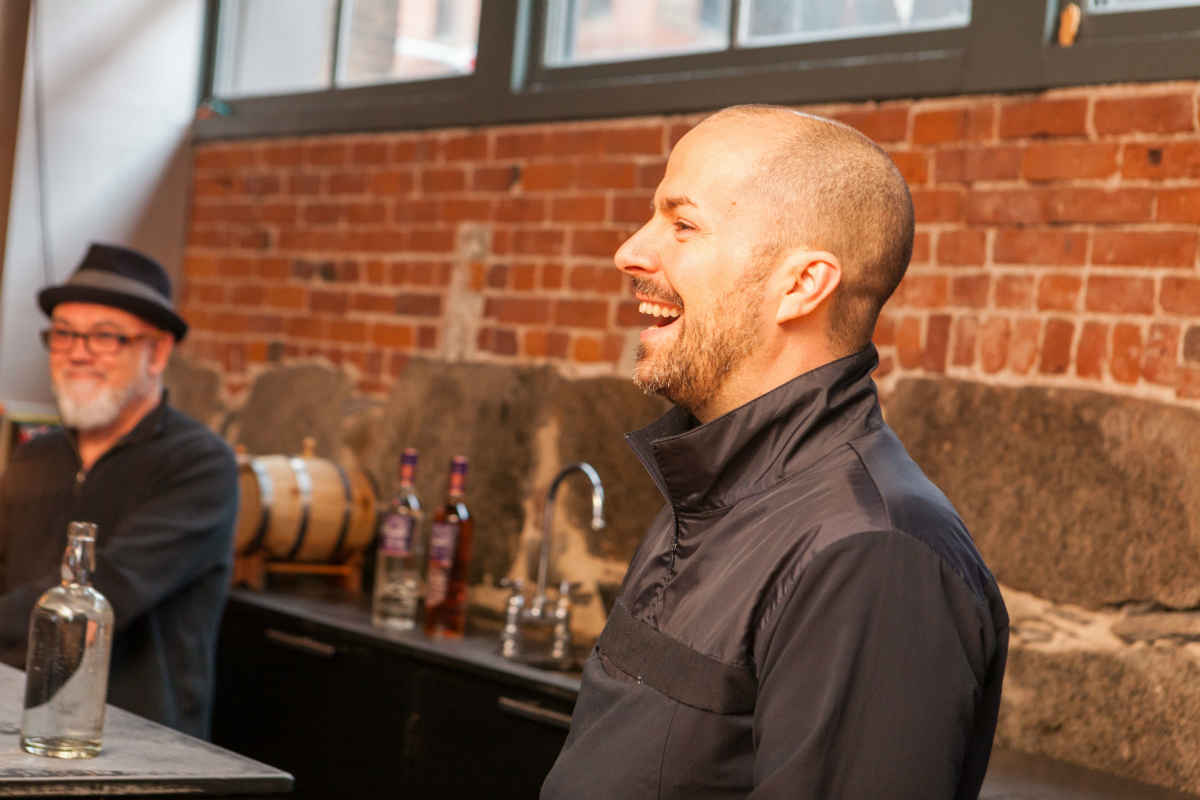The cocktail world draws a pretty diverse crowd of people. But what unites all of them, from dive-bar heroes to mustachioed mixologists, is a deeply-ingrained creativity and dedication to their craft—traits that, in many cases, lead to an equally powerful competitive streak. Fortunately for those inclined to show off their skills, the last decade or so has seen a pretty drastic rise in the number of prestigious competitions where they can do just that.
Squarely in the fray at many of them has been 15 Romolo bar manager and San Francisco US Bartender’s Guild (USBG) Vice President Andrew Meltzer. In recent years, he’s been a national finalist in major events from Diageo World Class and Bacardi Legacy to the grueling USBG/IBA Shake It Up! competition, as well as making his way to the global finals of the Domaine de Canton Bartender of the Year competition in 2014. And all the while, he’s been climbing the ladder at one of the most prestigious bars in the country.
Heading West
Originally from Boston, Meltzer first made his way to the West Coast just over three years ago. “I came up to San Francisco for Outside Lands in 2011, just on a whim after seeing it on the cover of Rolling Stone, and I spent the next 15 months telling myself I was going to move here. It was that classic, ‘left my heart in San Francisco’ story.”
But, a bit surprisingly for someone who has demonstrated such technical and competitive skill, he had barely any experience with craft cocktails when he got here. “I’d been working in various beer bars and gourmet pizzerias for about five years in Atlanta, and I was a big beer nerd. I had started getting really into whiskey and wine, and I wanted to start getting into the cocktail thing, which I knew was a big deal out here. But the problem was that I didn’t know anything about it.”
After a failed attempt by Meltzer and his manager to start a cocktail program at one of those Atlanta beer bars, he was nonetheless hooked. He joined his local chapter of the USBG, did his best to make some contacts, and then packed everything he owned into a Penske truck and drove across the country. It was a risky move, considering he only knew one person in San Francisco with a couch available to sleep on.
“When I got to town, I reached out to the one or two connections I had made through the USBG, and I asked them to send my resume around to anyone they knew in SF. I made this terrible resume, with a bunch of awful headshots included. I was wearing a suit and tie and holding a bottle of Campari, which I knew nothing about,” he laughed. “So I sent that all around San Francisco, and everybody made fun of it—Kevin Diedrich actually found my resume and photos and posted them all over the Facebook a few weeks ago, it was pretty hilarious.”
15 Romolo, a sultry, back-alley cocktail bar attached to the historic Basque Hotel in San Francisco’s North Beach neighborhood, was Meltzer’s first choice. Conveniently for him, it was also one of the places his resume had landed before he arrived. “I came here one day and rang the doorbell to the hotel, and I was just really hoping somebody would even answer. A woman opened the door and she said, oh yeah, we were expecting you! I just kind of took yes for an answer. She said that I couldn’t bartend, but I could barback on Thursdays and Saturdays, and I said, hell yeah, I’ll take it. Since then I’ve worked every position here.”
Mixing it Up
Meltzer is known for being a fairly prolific—and wildly intricate—developer of cocktail recipes, both for competitions and for the menu at 15 Romolo. He tweaks his drinks with obsessive attention to detail, crafting each ingredient himself if he can, and the results are impressive.
When we asked him about his methodology and sources of inspiration, it was like turning on a firehose of fascinating cocktail geekery. “I’m very concept-driven. I like to start with an idea, like a cream soda, and work it backwards. I ended up making an Irish whiskey-based clarified milk punch that got rid of the lemon juice, and instead I used citric acid, which gave it a nice little kick. Then we used some Chardonnay eau-de-vie and a little nocino, a black walnut liqueur, as well as a homemade kolsch syrup, made from kolsch beer reduced down with vanilla beans and a little bit of cinnamon. Then it’s topped off with soda and a tiny bit of Angostura bitters.
“You get this clarified Irish whiskey cream soda, with a little vanilla and butterscotch flavors, the super deep, dark richness from the nocino, and the kolsch is really alive, giving you that frothy, foamy, beer-like mouthfeel. It’s really weird, really complex, and it had to be a completely pre-batched, pre-bottled cocktail that you just pour over ice, add soda and an orange twist. It’s amazing on a Friday night, because it’s the easiest cocktail to make,” he said, laughing. “But it’s also one of the most complex ones to prepare, and it takes a lot of fine-tuning and precise measurement.”
Over the course of our conversation, Meltzer explained the alchemical thinking behind a number of his other original cocktails, many of which he’s used in competition. He was kind enough to share the details with us on Bevvy, so you can try your hand at making them yourself (these aren’t nearly as complicated as that Milk Punch, we promise). Standouts include the Cuban Cobbler, his entry that made it to the national finals of last year’s Bacardi Legacy competition; the 1 Up (Magic Mushroom), a rum, cognac, and sherry cocktail that won the Diageo World Class Food Pairing Challenge; and a number of drinks from past and present menus at 15 Romolo.
A Competitive Streak
To put those competitions in perspective, Meltzer explained that each has its own unique (and often sadistic) structure and quirks. Diageo World Class, for example, is broken up into several distinct segments. “Last year was the first year that I made it to the finals, and it was just the most exhausting, intense thing I’ve ever done. It’s six different challenges over three days, including the final challenge, which is a speed competition of six cocktails in eight minutes, with three of the most intimidating judges on the planet. And it’s a great program, probably my favorite, because whether you win or lose you get this great, written feedback on what you did well and what you didn’t.”
It also includes an element of creativity that goes well beyond the glass. “One of the most interesting things World Class does is a bottle service challenge, and the theme changes every year and with each round of the competition. You put together this whole persona and experience, and you present the judges with a kind of themed tasting menu. For the regional competition last year, your theme had to be something inspired by a movie or director, and I chose Forrest Gump. I played Forrest Gump for ten minutes, without breaking character. I dressed up in a costume, set up a park bench and everything.
“For the bottle service you’re not behind a bar serving a cocktail, you’re in a private room that you can set up any way you want. The idea is that you serve a neat pour of one of their premium spirits—Bulleit Bourbon, Ron Zacapa, Tanqueray Ten, Johnnie Walker, Don Julio—and then you serve side items with it, so maybe a drink on the side, some syrup they can add to it themselves, some food, a cigar, or whatever it is that brings them into the movie.”

Meltzer mixes a Daiquiri behind the bar at 15 Romolo
On the other end of the spectrum of free-wheeling self-expression is the USBG/IBA Shake It Up! competition, which follows the strictures of the International Bartender Association to an extreme degree. “There are four judges, three that taste your drink and one that starts off with 32 points, and every time you mess up he deducts a point,” he explained. “You have to show the label on each bottle very clearly to the judges and audience, and when you pour it you have to wipe off the bottle with a nice little white linen cloth. Anything else you’re using that might have a little drip on it, you have to clean off as well. It’s a lot like those sommelier exams, very elegant and, well, strict.
“You have to take a lot of precautions to make the best cocktail. You have to pre-chill your glassware, you have to prove that you’ve strained the water from the melting ice off of it and show the clear-but-chilled glass to the judges, you have to pre-chill your tins somehow, and not touch your hand to any part of the tin that will later contact the cocktail. You can’t touch the lip of the glass, you can’t touch your strainer anywhere but the handle… it’s all about being clean and sanitary, and very exacting. And you have to do all of that while making four cocktails in seven minutes,” he laughed. “And there’s an MC who’s walking around and asking you questions the whole time you’re on stage.”
It’s an extraordinarily challenging competition, and one that most bartenders balk at for its impracticality—but not Meltzer. “When you’re training for one of those events, you’re saying, ‘no way could I do all these things on a busy Friday night.’ And yes, it’s hard to do all of them, but it’s definitely possible to do many of them. It makes you look better, it adds more value to your drinks, and it makes for a better show for your guests. It’s great publicity, but it’s not pointlessly pretentious. You’re doing everything for a reason: to make a better drink.”
Always Looking Forward
Though a national title has eluded him so far, Meltzer is determined and already back at it in 2016—a third-place finish at World Class, after all, is certainly nothing to sneeze at after just a few years in the industry. He doesn’t attribute that meteoric rise to anything particularly special, though, and insists that aspiring bartenders can do the same if they’re willing to learn.
“A lot of it is just experience. You have to go on USBG tasting tours, or go to events where you’re tasting all these things, or learning from the distillers and the brand ambassadors, as annoying as they may be sometimes,” he laughed. “A lot of it I’ve learned from other bartenders and my boss. When you see a menu with 50 different bourbons on it, you’ve got to know three things about each of those bourbons if you want to be a good bartender.
“A lot of it is expanding your own palate in as many ways as you can. That’s one of the hardest things to do, just training your palate, and you can’t develop new recipes without it. I get up early on Saturdays to go to the Ferry Building farmer’s market, because it’s just the best way to learn what’s in season and fresh. It’s unreal. When you go there and you see 25 different farmers with 25 different varieties of peppers, well, damn, you should be making some pepper cocktails.”
We’re sure we’ll be seeing exactly that on 15 Romolo’s menu as we get into the summer months, but in the meantime we’ll have to tide ourselves over with Meltzer’s inscrutably delicious Clarified Milk Punches—and appreciate the fact that we were never masochistic enough to try our hands at an IBA competition.
All Photos: Will Shenton / Bevvy





